Although cats are the number one lethal threat to birds, collisions with building glass are not far behind. The number of birds killed each year by glass collisions worldwide is estimated to be in the billons. In the United States, the U.S. Fish & Wildlife Service estimates that between 400 million and one billion birds die each year from collisions with buildings. In contrast, an annual average of only 250,000 bird deaths result from collisions with land-based wind turbines. See also: Aves; Building; Glass; Wind power

For birds in flight, glass windows and sheathing appear invisible or reflect the natural environment, be it the sky or the surrounding habitat. High-rise buildings (12 stories and higher) actually account for very few bird deaths, with low-rise buildings (4 to 11 stories) and residential houses (rural as well as urban) each accounting for about 50 percent of bird deaths. To prevent birds from striking windows, glass needs to be less reflective or marked with patterns that birds can see and will fly around. To be visually effective, all bird-friendly glass treatments need to be on the exterior of the glass.
To make glass more visible to birds, lines, dots, or other patterns can be painted onto exterior glass surfaces. The pattern should be non-reflective and 2 inches (5 centimeters, or less) high or 4 inches (10 centimeters, or less) wide. Another patterning technique is to use ultraviolet (UV) reflecting designs coated onto the glass, because birds are able to see the UV portion of the light spectrum. Although not perfect, when humanely tested, birds are able to avoid UV-patterned glass about 67 percent of the time. See also: Color vision; Light; Paint and coatings; Ultraviolet radiation

To make glass less reflective or non-reflective, the glass may be textured, etched, or fritted. Texturing involves engraving or patterning semi-molten glass to produce translucent and non-reflective glass. Acid etching of glass produces a frosted surface that is non-reflective. Fritted glass is made by screen printing an ink-like composition of glass nanoparticles (frit) on glass and then heating the glass to 1150°F (620°C) to fuse the frit to the glass surface to produce an opaque and non-reflective coating. Frit can be printed as lines or dots. All of these techniques make buildings more visible and less deadly for birds. See also: Nanoparticle
Homeowners or renters can also do their part to reduce bird collisions with glass. Birds are attracted to plants, so moving large plants away from windows can be helpful. Installing screens or tightly stretched netting far enough in front of windows to prevent contact with glass is another strategy. Applying tape, decals, or tempera paint to windows in patterns that are 2 inches high (5 centimeters high) or 4 inches wide (10 centimeters wide)—or narrower—helps prevent collisions. Because not all windows will cause bird strikes, the U.S. Fish & Wildlife Service recommends checking windows for reflections of the natural environment as well as looking for dead birds under windows and inspecting window surfaces for feather prints.





